All you need to know about your products!

| 3DNews Vendor Reference English Resource - All you need to know about your products! |
||||||
 |
||||||
|
|
||||||
Intel Centrino Duo: new-generation mobilityAuthor:Date: 24/01/2006  For new generations of Intel mobile PC platforms under the common name Centrino , the first quarter has traditionally become the time of official emergence to the world. It seems like just the first month of year will be traditionally the time for that. In 2005, January became the month for announcement of another version of Intel Centrino codenamed Sonoma, and this January – of version Napa. I won't be surprised if the next generation of Centrino – the Santa Rosa, will also take its official launch also in January, but in 2007. Announcement of a new Centrino version is always the largest event in the industry, but this year Intel decides to merge a number of no less important events concurrently with that announcement. Above all, it is the first official emergence of the innovative technology Intel Viiv for home-based PCs (Entertainment PC). 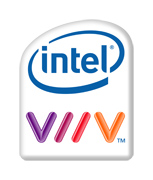
We will certainly devote one of our further materials to the "entertainment" PCs based on the new Intel Viiv technology which allows to view, control and jointly use digital entertainment media for all the family members. Of course, we will introduce our readers to both the technical points of the Intel Viiv architecture and its specific implementation details - the volume of materials on the subject and specific examples has finally reached a sufficient level. There aren't any doubts that among all other facts the Intel Viiv is obliged to the thrilling success of the mobile Centrino platform for its emergence. In fact, mentioning the Intel Viiv in this article doesn't mean an "abstract talk" because today the following is known for sure: chips of the Intel Core Duo family will operate not only as part of the mobile PC of the Intel Centrino Duo platform, but also in some models based on the Intel Viiv technology. Inspired by successful sales of Centrino kits for many years, Intel last year decided to re-use the experience of delivering finished and mutually certified base components for building reliable computer systems (not just standalone components) in other sectors – servers, desktop PCs, smart-phones, and communicators. We will see very soon what will come of the idea of turning a desktop computer into an item of household electronics together with TV-sets, audio/video systems, vacuum cleaners, because deliveries of systems based on the Intel Viiv have already started. But that is a matter of another material. Another event that accompanied the announcement of the new generation of the Centrino platform is Intel's complete rebranding. Putting it in a human, not marketing talk, Intel has started this year with a mass replacement of its slogans and trademark names, as well as changes to the exterior of numerous logos - corporate, branding, product-related. For those who are used to finding their ways in the PC world by the word "Pentium" heard over the TV are in for uneasy times: they will have to learn new unknown terms which will now be used in combination with the company name. For reference: Intel's current rebranding is merely the third for the whole history the company has been around. Of the previous versions, we can now recall the Intel Memory brand introduced in 1985, then the Intel Pentium which was introduced in 1987 and further commercialized in 1988, as well as Intel Centrino which was the first try of Intel's in the field of platforms that came into being in March 2003. Try memorizing the below logos: while today they still can be seen on various products, they will be a museum exhibits in quite a short time.
So, what comes as a replacement? In exchange of the old logos, there have come new ones made in a unified style. For instance, this is how Intel's new corporate logos look: 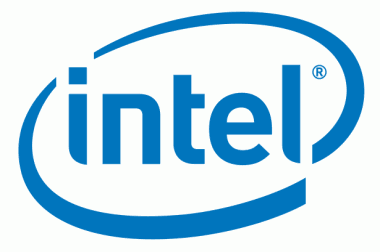 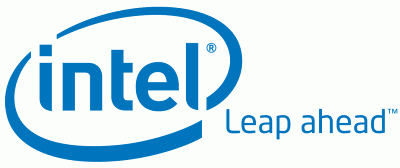 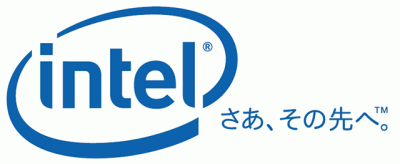 This is how logos for mobile and desktop PC platforms look (above the line) and the logos of Intel's processors for mobile, desktop and server systems: 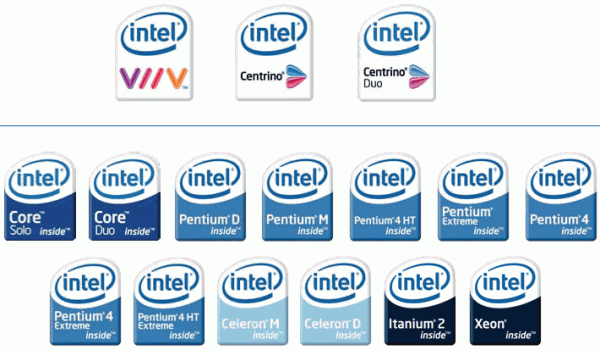 In the solid residue - the way the inscription of the company name has been changed, the delineation started looking absolutely different, and new brands have come into being. Today, we are talking about introductions for the mobile platform, which are not only for image-making. The path of Centrino: from the platform concept to the industry standardThe fourth generation of Intel Centrino for mobile PCs in the form of Intel Centrino Duo presented these days used to be codenamed Napa. The key improvements which make the new version stand out from the previous platform codenamed Sonoma can be classified over the four vectors of progress:
The name of the new platform - Intel Centrino Duo - quite vividly shows its key design feature: use of Intel Core Duo processors, first 2-core Intel chips for mobile PCs (formerly having the working name Yonah) created following the 65-nm process technology. Besides that, the full kit of Intel components to assemble a notebook computer that pretends to bear the Intel Centrino Duo logo, must contain the new-generation chipset Intel 945 Express and the wireless LAN adapter Intel PRO/Wireless 3945ABG with support for 802.11a/b/g protocols.  Prior to going into the technical details, let's finish with the marketing details of the new Intel's mobile platform. In fact, together with the notebooks which bear Intel Centrino Duo logos we'll soon see novelties labeled as Intel Centrino on the retail shelves. The major distinction between these versions, as is easy to guess, is the use of 2-core (Yonah DC) and single-core (Yonah SC) processors, respectively. Moreover, on the market there will soon be notebooks with new 65-nm Intel's processors - both single-core and dual-core, but in combination with third-party chipsets and wireless adapters. As before, such portable PCs can't pretend for bearing Centrino logos, but this time Intel has introduced special new logos for mobile processor brands - Core Duo and Core Solo. Here is a summary table for a distinct definition of the brand marking:
But the issue of marking to be used for Core Duo/Solo series processors with the cut-down L2 cache is still "in the air" (I am absolutely sure that chips similar to Celeron M will emerge within one or two quarters). Most likely, the respective logos will just be presented at the moment of their announcement. Describing the overall specifications of notebooks based on Intel Centrino Duo for mobile PCs, Intel accentuates the improved 3D graphics, use of the HDTV, support for 7.1-channel Intel High Definition Audio with Dolby Digital. On the whole, notebooks demonstrate an increasing productivity due to a higher performance in the multitasking environment and improved facilities for shared work, as well as support for IP-telephony, IP-videoconferencing and prolonged time of offline battery operation. The new platform also supports Intel Active Management Technology and Intel Virtualization Technology which improve the manageability and security of the PC, with the small dimensions of components making it possible to create notebooks of varied designs within a wide size range. It should be also mentioned that the operation life can be prolonged with the operating costs cut down with Intel Stable Image Program, There is also the possibility to prepare it for Windows Vista due to graphics optimized for the new Aero GUI. Intel Core Duo and Core Solo processors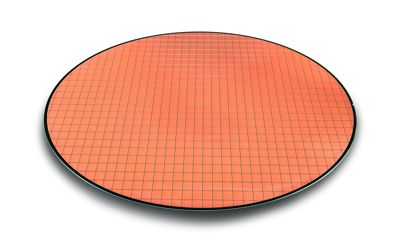 Along with the new 65-nm process technology used in the production of Core Duo (Yonah) chips, which allowed to reduce the dimensions of transistors and increase the density of positioning components on the chip, processors built on the Yonah core offer a number of the following characteristics:
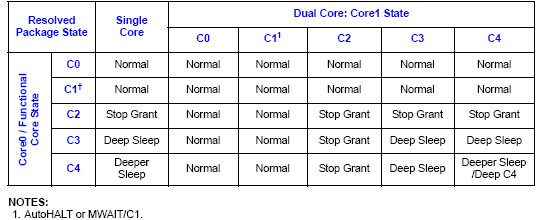 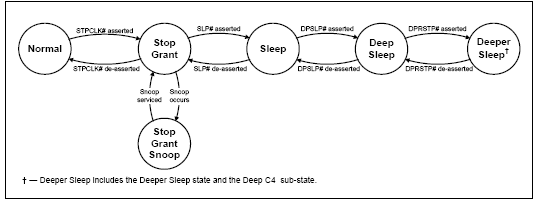 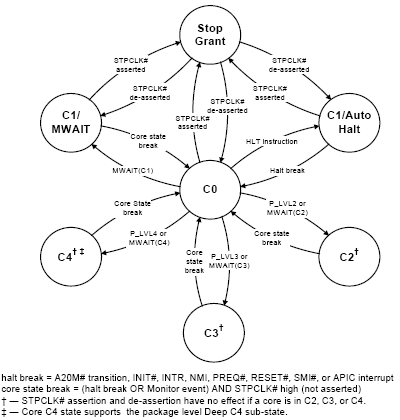
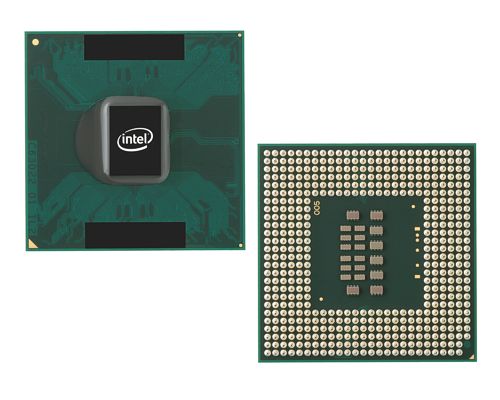 Commenting on the changes that have appeared in the Yonah chip as compared to the previous generations, apart from implementation of the 2-core mechanism with shared distributed resources, we can also note the increase of the bus speed– from 533 MHz in the Dothan core to 677 MHz in Yonah, as well as the newly added support for SSE3 instructions, plus the mechanism of merging micro operations SSE, SSE2 and SSE3 on the background of improved algorithm for floating-point computations and some other instructions of the SSE set. Of the huge set of new "4 Ts" technologies which includes the LaGrande hardware security, Vanderpool virtualization, support for 64-bit EM64T extensions (Extended Memory 64 Technology, i.e. Clackamas) and multithreading on the level of a single core - Hyper-Threading, the Intel Core Duo chips feature in support for the Vanderpool, which is still at the level of future implementation. Anyway, we shouldn't dream of the LaGrande implementation until the Microsoft Vista (Longhorn) has been released, whereas support for EM64T and the 36-bit of physical address (64 GB) memory space seems to be implemented in Merom cores. Frankly, for those who are into using Core Duo chips according to its intended use – in notebooks, it's not a great loss, but those who are after building new blade-servers will have to be content with what's there or wait for the next generation of chips. With Hyper-Threading, the situation is still the same: until the SMT-architecture is implemented, we'll use 2-core Yonah in the 2-thread mode due to two cores. A few words on the scheme for marking the new generation of Intel mobile processors - the so-called Processor Numbers. Marking of all Intel Core/Core Duo chips is made up of the single-letter prefix and a 4-digit number. The letter has a direct connection to the classification of the TDP chip. Currently, there are four letters reserved for Intel Core/Core Duo processors:
The first digit of the 4-digit index stands for the number of cores: the 2-core Intel Core Duo (Yonah DC), therefore, is indexed as 2XXX, whereas the 1-core Intel Core Solo (Yonah SC) as 1XXX. The remaining three digits stand for the performance index relative to other chips of the family, in 100 increments, although I wouldn't be surprised if the increment turns smaller once new buses or other improvements to the cores come up. To date, the line of 2-core Intel Core Duo processors includes the chips T2300, T2400, T2500 and T2600 which sell at the wholesale prices (for 1000 pcs onwards) set to $241, $294, $423, and $637, respectively. The Core Duo T2700 chip of 2.33 GHz clock speed is expected to be released in the second half of 2006, most likely in the third quarter, then we can expect the news of the emergence of first Merom chips. The family of single-core Intel Core (Yonah) processors is currently represented by one chip - the T1300 (package FCBGA6/FCPGA6) which offers 2 MB of L2 cache, supports the 1.66 GHz clock speed and FSB 667 MHz (wholesale price - $209). At the same time, Intel has also started deliveries of Low Voltage 2-core Core Duo L2400 and L2300 processors which offer 2 MB of L2 cache, support for 667 MHz FSB, and clock speeds 1.66 GHz and 1.50 GHz ($316 and $284, respectively). To be fair, I note that Intel's documentation also mentions the first Ultra Low Voltage 2-core Intel Core Duo U2500 processor, but it is not yet included into the price list, so I can't yet tell the specifications, except that the system bus of Ultra Low Voltage Intel Core Duo processors runs at 533 MHz, with the nominal clock speed being 1.06 GHz. They say that U2500 along with its single-core brother Intel Core Solo U1300 will appear soon enough. As regards the wholesale price of the kit required to obtain the Centrino Duo/Centrino logo, let me bring in a couple of examples. The "maximum kit" comprising a processor T2600, integrated Intel 945GM chipset, and a Wi-Fi module Intel PRO/Wireless 3945ABG will cost $706; a kit made up of a single-core T1300, discrete Intel 945PM and Intel PRO/Wireless 3945ABG adapter will cost merely $274 of wholesale price. For details of the list with the additional price info, read the official Intel's price-list page. The key specifications of all the new-generation Intel mobile chips have been summarized into the below table.
As you see, things have not yet got round to chips with TDP of 50 W, however, it is probable that such chips will work as part of notebooks of the DTR class (Desktop Replacement) or in systems of the Intel Viiv platform. Processors of the ULV class will fall within the category indexed U, while the classical versions - within the class T, and LV versions - within the L category. I'd like to draw your attention to the fact well seen from the above table: the clock speed of all the new Intel Core Duo/Solo processors with the SpeedStep technology enabled drops to a level below 1 GHz. Despite that the TDP of 2-core Core Duo chips is normed at 31 W, in the saving mode at the core voltage 0.95 V the chips are able "fitting within" the TDP at merely 13.1 W, which can be called an excellent indicator for such an important component of the new generation of notebooks. According to the documentation for the previous generation of Centrino platform, Dothan processors offer TDP at about 27 W, the LV of the Dothan version - about 10W and ULV of the Dothan version - about 5.5 W. With Yonah cores, the classification turns somehow complicated: the TDP of a typical 2-core Yonah DC chip of T class is normed at 31 W, for the single-core Yonah SC - at 27 W, of the 2-core LV Yonah DC chip - 15 W, the ULV version of Yonah DC chip - 9 W, single-core Yonah SC chip - 5.5 W. As you see, there is some reduction of the dissipated power even among 2-core chips as compared to their 1-core predecessors. However, we won't be happy for long: the new generation of 2-core Merom chips will offer the TDP of about 34 W, which will make the indicator get closer to 35 W in the good old Pentium 4-M of three years age.  Mobile Intel 945 Express chipset family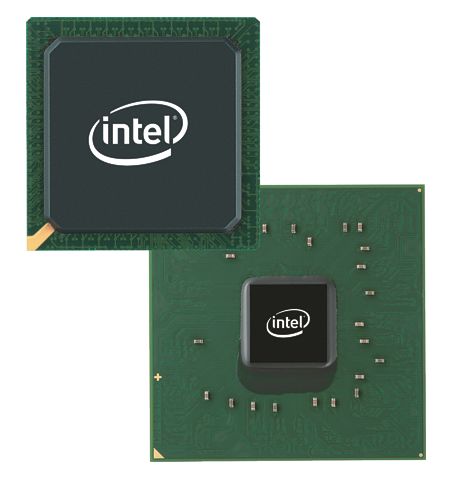 The new generation of "mobile" Mobile Intel 945 Express chipset for use in combination with Intel Core Duo/Solo processors has come as a replacement to the Mobile Intel 915 Express series and was known during the development of the Napa platform under the Calistoga working name. These days, the family of new chipsets includes two versions of the north bridge – the discrete Mobile Intel 945PM Express and integrated Mobile Intel 945GM Express. The chipsets are equipped with the mobile version of the south bridge- ICH7-M and appear to be improved, modified and economical versions of Intel 945G/P presented in May last year for desktop PCs. 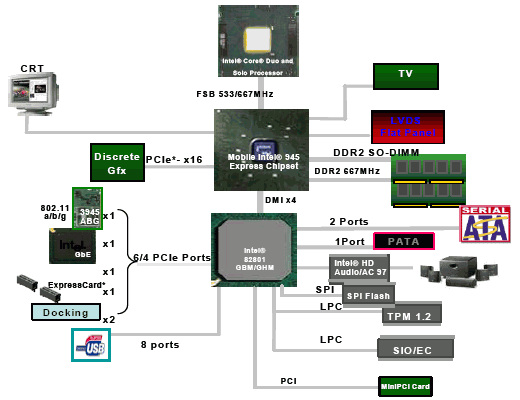 The new generation of mobile chipsets offers the system bus optimized for power-consumption, running at 667 MHz, support for the PCI Express x16 and up to 4 GB 2-channel DDR2 400/533/667 memory. The chipsets offer power management tools - Intel Rapid Memory Power Management, which allow saving the power consumed by the chipset and DIMM DDR2 modules through switching the memory to the state of reduced power consumption with the display staying active. 
We should also mention the Intel Display Power Saving 2.0 technology that reduces the display backlight power consumption with the minimum visual effect to the user, which allows elongating the time of offline battery operation; the Intel Automatic Display Brightness technology which automatically adjusts the display backlight intensity as per the ambient illumination level; the Intel Matrix Storage technology with the Link Power Management feature that allows to boost performance, manage the power consumption and protect data in data storage subsystems. The 4-pipeline graphic core Intel Graphics Media Accelerator 950 (GMA 950) integrated into the Intel 945GM chipset is a the Gen 3.5 generation of Intel graphics and supports DirectX 9. The clock speed of GMA 950 chip has been raised from 200 MHz in Intel 915GM to 250 MHz in Intel 945GM, plus the hardware support for VLD/iDCT has been added. 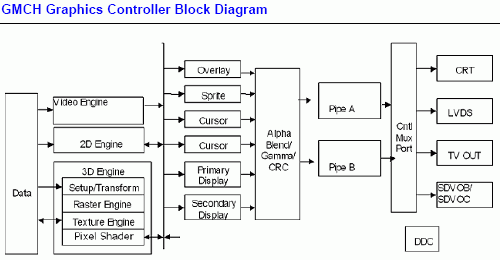 Additionally, of note is support for the Intermediate Z that eliminates polygons displayed in 3D applications; a full-featured MPEG-2 (SD & HD) decoding; support for D-connectors of all types (D1-D5) and any TV-sets, including HDTV; adaptive line scanning management that removes some visual artifacts while watching on-air TV on non-interlaced scanning displays, as well as the COPP/HDCP/CGMS-A technology which allows viewing protected high-quality video with the content copy-protected. Along with the above listed, the Mobile Intel 945 Express chipset offers support for 7.1-channel Intel High Definition Audio at 32-bit/192 KHz bit-rate; up to USB 2.0 ports. There is the DMI (Direct Media Interface), the LVDS interface, integrated TV-out, independent outputs to two displays (Dual Independent Display), support for Serial ATA storage media. 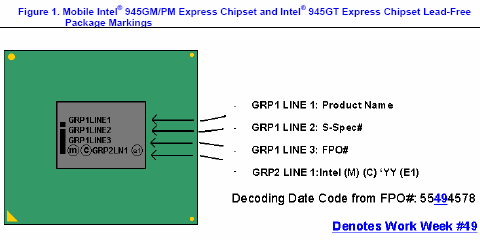 It is expected that in the second quarter presented will be value versions of the Mobile Intel 945 Express chipsets - Intel 945GMZ, Intel 945GMS, and Intel 940GML. Intel 945GMS is remarkable for its super-compact packaging – merely 27x27 mm, which determines its use in ultra-compact notebooks and mini-notebook models. Intel 945GMZ is a cut-down version of Intel 945GM and lacks support for the PCI Express x16 bus. Finally, the Intel 940GML with integrated graphics and support for FSB at merely 533 MHz is evidently aimed at operation with chips of the Celeron class, but this time based on Yonah cores.  A few words on further prospects for progress of mobile south bridges of the ICH7 series. All the notebooks, as was already stated above, will be equipped with the standard ICH7-M series, while solutions for the desktop platform Viiv will be shipped with both the ICH7-M version and with the ICH7-MDH version which offers additional support for six PCI Express x1 slots and the RAID feature. It's quite possible that support for RAID will be also implemented in the Napa platform, say, in the second-third quarter of 2006.  Wi-Fi in the Intel PRO/Wireless 3945ABG version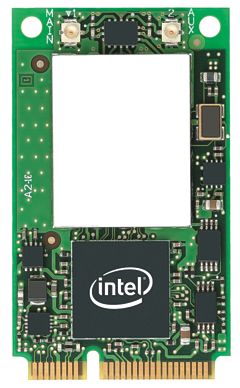 The new-generation wireless network adapter Intel PRO/Wireless 3945ABG, formerly named as Golan (working name) supports extended functional characteristics which improve the communication capabilities of application systems and reducing their response times. The adapter offers support for IEEE802.11a (5 GHz/54 Mbit/s), IEEE802.11b (2.4 GHz/11 Mbit/s) and IEEE802.11g (2.4 GHz/54 Mbit/s). Among the key characteristics of Intel PRO/Wireless 3945ABG, the following are worth mentioning:
The Intel PRO/Wireless 3945ABG Wi-Fi adapter is produced in the mini-card form factor for the PCIe bus (PCI Express x1, 1/2 mPCI format), which allows creating thin and light notebooks. Due to the possibility to use Intel PROSet/Wireless version 10, corporate customers can leverage the new IT administration tool and API interface which is meant to provide quality of service (QoS) as per 802.11e for IP-telephony.  Performance and economy of the Intel Centrino Duo platformHaving sorted out with components of the Intel Centrino Duo platform, it's high time we estimated its capabilities. Unfortunately, at the moment our test lab hasn't got the test results for a real system running on the base of the Napa platform, and we'll have to restrict to a few slides produced in the course of system tests run at the Intel laboratory. It was just these graphs based on which the company's official press release reported "performance boost up to 68 due to the use of new 2-core processors, elongation of the offline battery-powered operation by up to 28%", etc. For now, there is only official data, but in the near future we will definitely please our readers with tests of real retail systems. 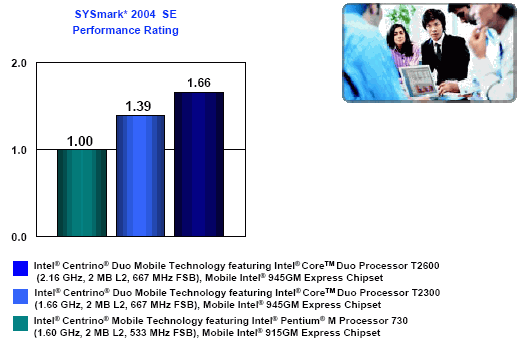 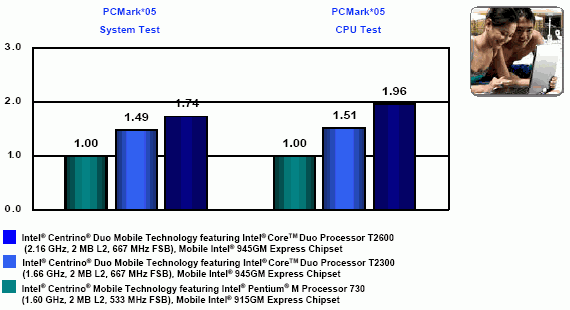 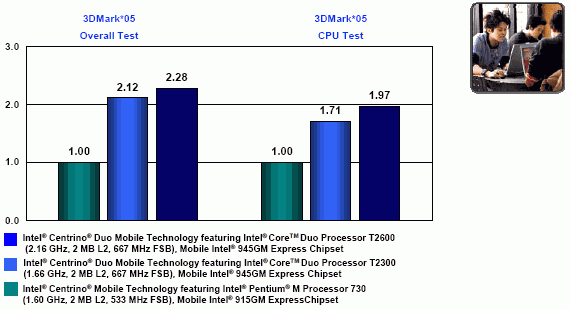 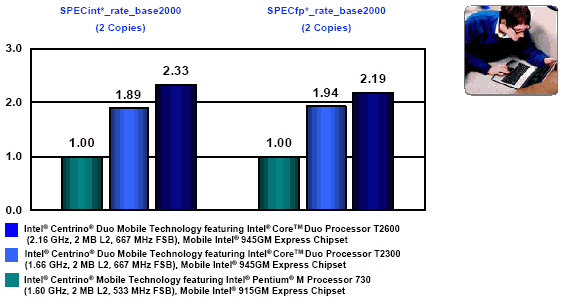 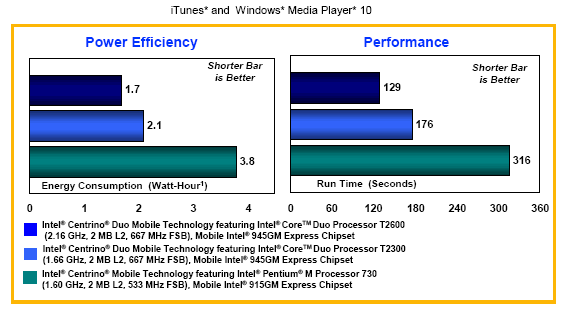 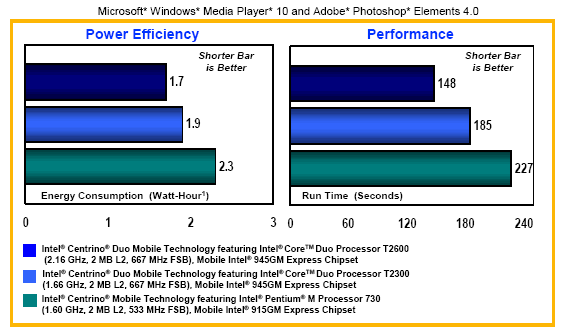 The final touch in describing the Intel Centrino Duo technology is a collection of information on the power consumption of new-generation mobile systems. According to the preliminary information of Intel's OEM partners, the overall power consumption of Napa-based systems is lower than that of the previous Sonoma generation. The below table shows the average (not peak, maximum, but average) power consumption of Intel Core Duo platform for comparison versus similar characteristics of the Sonoma platform.
With similar power consumption of Core Duo and Dothan chips, note how the power consumption by Intel 945GM and Intel 945PM chipsets have gone down as compared to the predecessors Intel 915GM and Intel 915M. Therefore, with the twice as less power consumption of the wireless adapter and south bridge the average power consumption for Napa platform components has dropped to 2.8 W versus 4.2W in Sonoma. The balanced choice of an economical display, storage media and other "voracious" notebook components will definitely let the developers achieve new records at the time of offline battery operation for Napa-based systems. As a bright example of model based on Intel Centrino Duo, I am bringing in the recently presented Dell Inspiron 9400 notebook which will hit the retail by the end of January. The novelty is equipped with a Core Duo T2500 processor of 2 GHz clock speed, Intel 945PM Express, NVIDIA GeForce 7800 Go graphics of 256 MB graphic memory, 2 GB RAM, a 100 GB HDD, as well as a luxurious 17" 1920 |
||||||||||||||||||||||||||||||||||||||||||||||||||||||||||||||||||||||||||||||||||||||||||||||||||||||||||||||||||||||||||||||
|
|||||